Continuous Estimation of the Crack Growth Rate during Rotating‒Bending Fatigue Testing
Abstract
:1. Introduction
2. Materials and Methods
2.1. Calculations
2.2. Test Conditions
Specimen Geometry and Heat Treatment
2.3. Crack Measurements and FEM
3. Results and Discussion
4. Conclusions
Author Contributions
Funding
Acknowledgments
Conflicts of Interest
List of Symbols
| α = Normalized crack size |
| a = Average crack length |
| C = Material constant |
| D = Diameter of the gripped or loaded end of the specimen |
| D0 = Nominal diameter of the specimen at which the stress is the greatest |
| Dff = Diameter of the final fracture |
| Dn = Diameter of the remaining cross section after n cycles |
| ΔK = Stress intensity factor range |
| ΔS = Stress range |
| d = Diameter of the shaft |
| da/dn = Average crack growth rate |
| δ = Deflection |
| E = Elastic modulus |
| FEM = Finite element modeling |
| I = Moment of inertia |
| K = Stress intensity factor |
| Kt = Stress concentrator |
| L = Distance between the load and the pivot point |
| M = Moment |
| M(y) = Bending moment at the surface of the specimen |
| m = Material Constant |
| n = Number of cycles |
| nf = Number of cycles to failure |
| P = Load (Force) |
| P0 = Initial load |
| Pn = Load at n cycles |
| POL = Load prior to overloading |
| Pf = Fracture load |
| r = Radius at the end of the test section |
| R = Ratio for cyclic loading (min/max) |
| RBF = Rotating bending fatigue |
| S = Stress |
| Sa = Stress amplitude |
| SEM = Scanning electron microscope |
| σnom = Nominal stress |
| Y = Configuration factor |
References
- Stephens, R.I.; Fatemi, A.; Stephens, R.R.; Fuchs, H.O. Metal Fatigue in Engineering, 2nd ed.; John Wiley & Sons, Inc.: Hoboken, NJ, USA, 2001; ISBN 978-0-471-51059-8. [Google Scholar]
- Manson, S.S.; Halford, G.R. Fatigue and Durability of Structural Materials; ASM International: Materials Park, OH, USA, 2006; ISBN 0871708256. [Google Scholar]
- ASM Handbook Vol.19-Fatigue and Fracture; ASM International: Materials Park, OH, USA, 1998; ISBN 0871703858.
- ISO 1143:2010 Metallic Materials—Fatigue Testing—Rotating Bar Bending Fatigue Testing; International Organization for Standardization: Geneva, Switzerland, 2010.
- JIS Z 2274:1978 Method of Rotating Bending Fatigue Testing of Metals; Japanese Industrial Standards: Tokyo, Japan, 1978.
- Eleiche, A.; Megahed, M.; Abd-Allah, N. Low-cycle fatigue in rotating cantilever under bending II: Experimental investigations on smooth specimens. Int. J. Fatigue 1996, 18, 577–592. [Google Scholar] [CrossRef]
- Megahed, M.M.; Eleiche, A.M.; Abd-Allah, N.M. Low-cycle fatigue in rotating cantilever under bending I: Theoretical analysis. Int. J. Fatigue 1996, 18, 401–412. [Google Scholar] [CrossRef]
- Eleiche, A.M.; Megahed, M.M.; Abd-Allah, N.M. Low-cycle fatigue in rotating cantilever under bending. III: Experimental investigations on notched specimens. Int. J. Fatigue 2006, 28, 271–280. [Google Scholar] [CrossRef]
- Pawliczek, R.; Prażmowski, M. Study on material property changes of mild steel S355 caused by block loads with varying mean stress. Int. J. Fatigue 2015, 80, 171–177. [Google Scholar] [CrossRef]
- ASTM E647-15e1 Standard Test Method for Measurement of Fatigue Crack Growth Rates; ASTM International: West Conshohocken, PA, USA, 2016.
- da Fonte, M.; Reis, L.; de Freitas, M. Fatigue crack growth under rotating bending loading on aluminium alloy 7075-T6 and the effect of a steady torsion. Theor. Appl. Fract. Mech. 2015, 80, 57–64. [Google Scholar] [CrossRef]
- De Freitas, M.; Reis, L.; Da Fonte, M.; Li, B. Effect of steady torsion on fatigue crack initiation and propagation under rotating bending: Multiaxial fatigue and mixed-mode cracking. Eng. Fract. Mech. 2011, 78, 826–835. [Google Scholar] [CrossRef]
- Jordon, J.B.; Bernard, J.D.; Newman, J.C. Quantifying microstructurally small fatigue crack growth in an aluminum alloy using a silicon-rubber replica method. Int. J. Fatigue 2012, 36, 206–210. [Google Scholar] [CrossRef]
- Shin, C.S.; Chen, P. Fatigue crack propagation testing using subsized rotating bending specimens. Nucl. Eng. Des. 2004, 231, 13–26. [Google Scholar] [CrossRef]
- Hannemann, R.; Köster, P.; Sander, M. Investigations on crack propagation in wheelset axles under rotating bending and mixed mode loading. Procedia Struct. Integr. 2017, 5, 861–868. [Google Scholar] [CrossRef]
- Gandossi, L.; Summers, S.; Taylor, N.; Hurst, R.; Hulm, B.; Parker, J. The potential drop method for monitoring crack growth in real components subjected to combined fatigue and creep conditions: Application of FE techniques for deriving calibration curves. Int. J. Press. Vessels Pip. 2001, 78, 881–891. [Google Scholar] [CrossRef]
- Hicks, M.A.; Pickard, A.C. A comparison of theoretical and experimental methods of calibrating the electrical potential drop technique for crack length determination. Int. J. Fract. 1982, 20, 91–101. [Google Scholar] [CrossRef]
- Stanzl-Tschegg, S. Very high cycle fatigue measuring techniques. Int. J. Fatigue 2014, 60, 2–17. [Google Scholar] [CrossRef]
- Bian, L.-C.; Lim, J.-K. Fatigue life prediction of the plates with an inclined surface crack. Int. J. Fatigue 2003, 25, 521–531. [Google Scholar] [CrossRef]
- McFadyen, N.B.; Bell, R.; Vosikovsky, O. Fatigue crack growth of semi-elliptical surface cracks. Int. J. Fatigue 1990, 12, 43–50. [Google Scholar] [CrossRef]
- Cai, C.Q.; Shin, C.S. A normalized area-compliance method for monitoring surface crack development in a cylindrical rod. Int. J. Fatigue 2005, 27, 801–809. [Google Scholar] [CrossRef]
- Mathieu, F.; Hild, F.; Roux, S. Identification of a crack propagation law by digital image correlation. Int. J. Fatigue 2012, 36, 146–154. [Google Scholar] [CrossRef] [Green Version]
- Miscow, G.F.; de Miranda, P.E.V.; Netto, T.A.; Plácido, J.C.R. Techniques to characterize fatigue behaviour of full size drill pipes and small scale samples. Int. J. Fatigue 2004, 26, 575–584. [Google Scholar] [CrossRef]
- Hosdez, J.; Witz, J.-F.; Martel, C.; Limodin, N.; Najjar, D.; Charkaluk, E.; Osmond, P.; Szmytka, F. Fatigue crack growth law identification by Digital Image Correlation and electrical potential method for ductile cast iron. Eng. Fract. Mech. 2017, 182, 577–594. [Google Scholar] [CrossRef] [Green Version]
- Szata, M.; Lesiuk, G. Algorithms for the estimation of fatigue crack growth using energy method. Arch. Civ. Mech. Eng. 2009, 9, 119–134. [Google Scholar] [CrossRef]
- Lesiuk, G.; Szata, M.; Correia, J.A.F.O.; De Jesus, A.M.P.; Berto, F. Kinetics of fatigue crack growth and crack closure effect in long term operating steel manufactured at the turn of the 19th and 20th centuries. Eng. Fract. Mech. 2017, 185, 160–174. [Google Scholar] [CrossRef]
- Timoshenko, S. Strength of Materials; CBS Publishers & Distributors: Lancaster, PA, USA, 2004. [Google Scholar]
- Pilkey, W.; Pilkey, D. Peterson’s Stress Concentration Factors; Wiley: Hoboken, NJ, USA, 2008. [Google Scholar]
- ASTM E647-08: Standard Test Method for Measurement of Fatigue Crack Growth Rates; ASTM International: West Conshohocken, PA, USA, 2008.
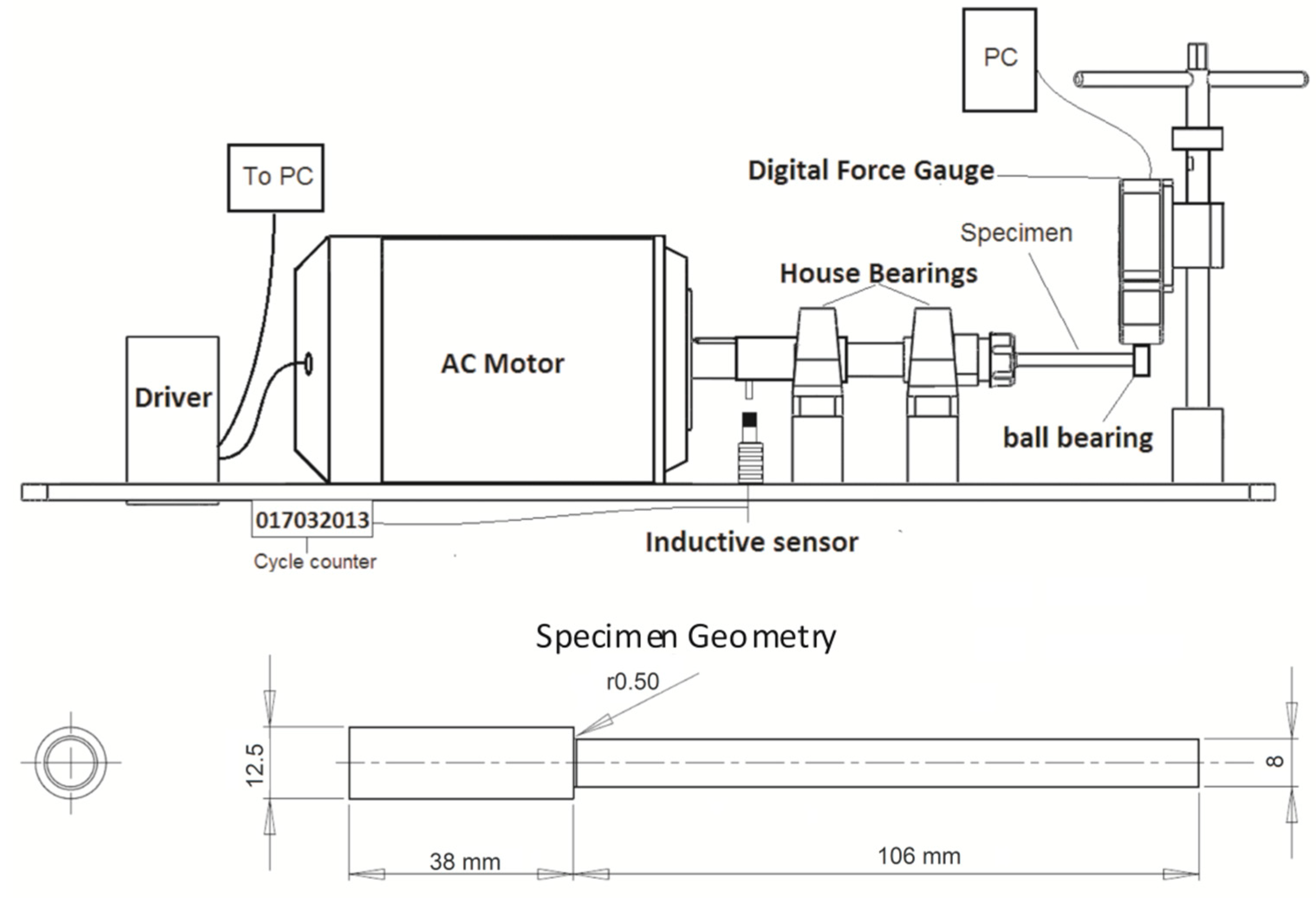
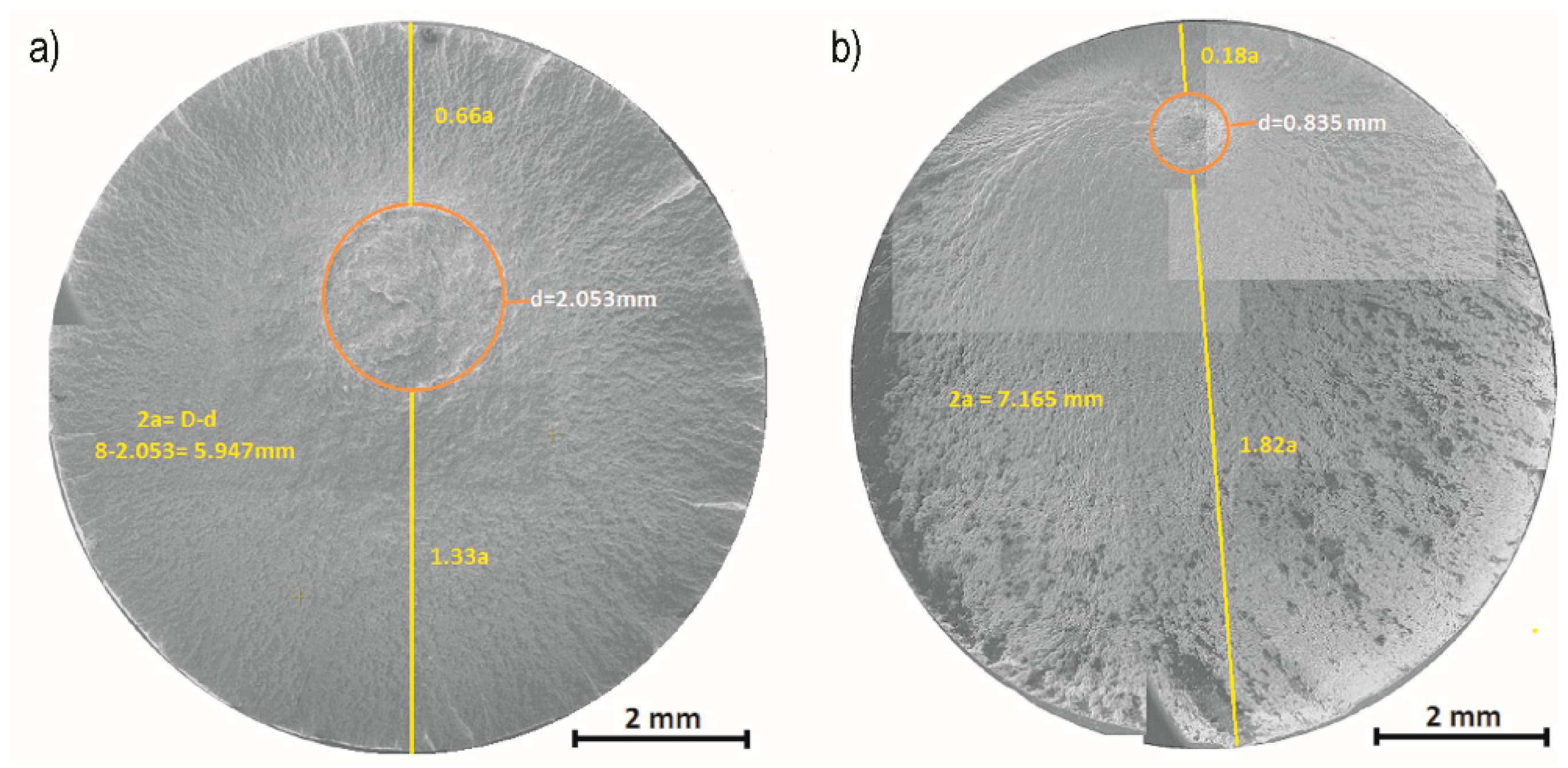

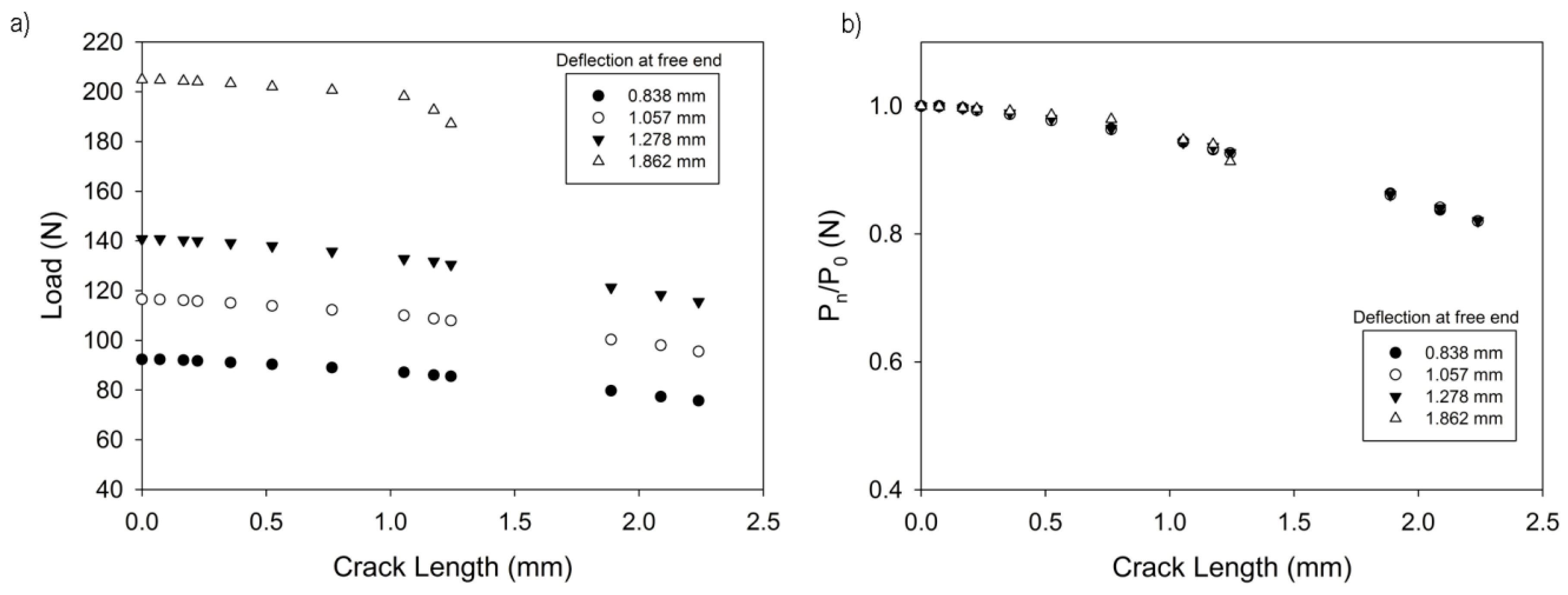
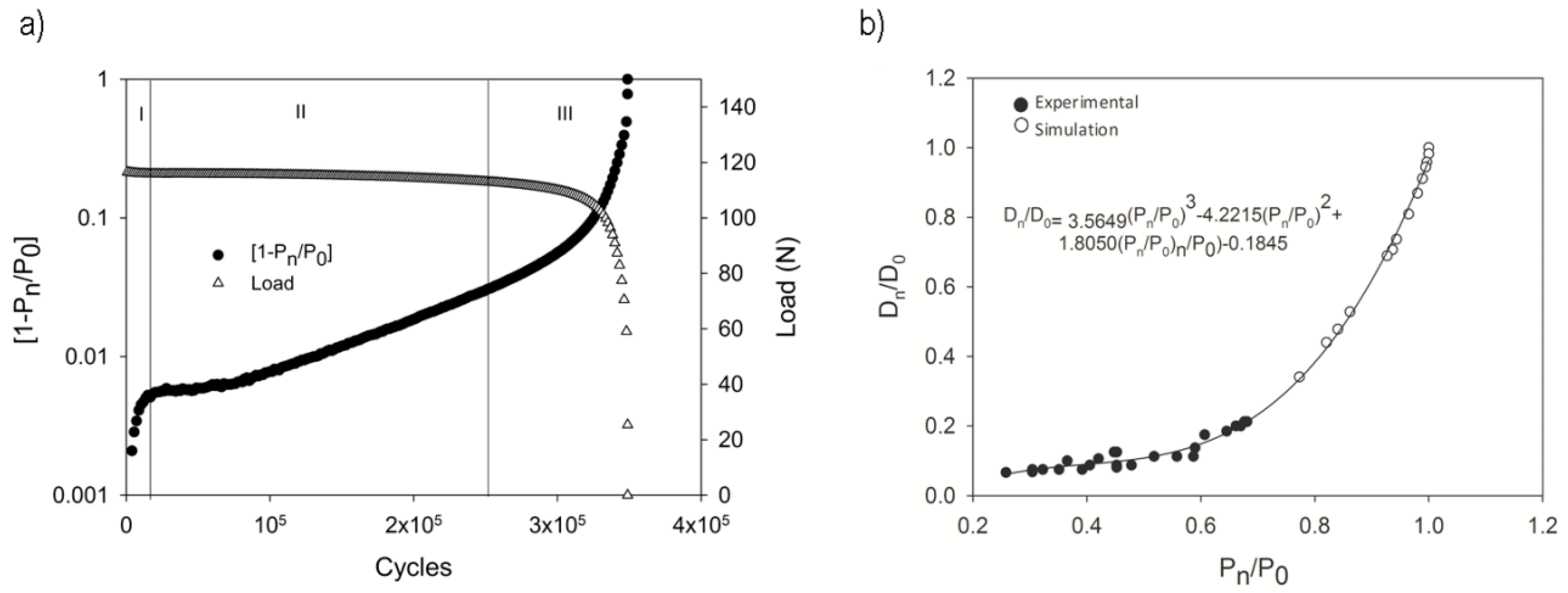
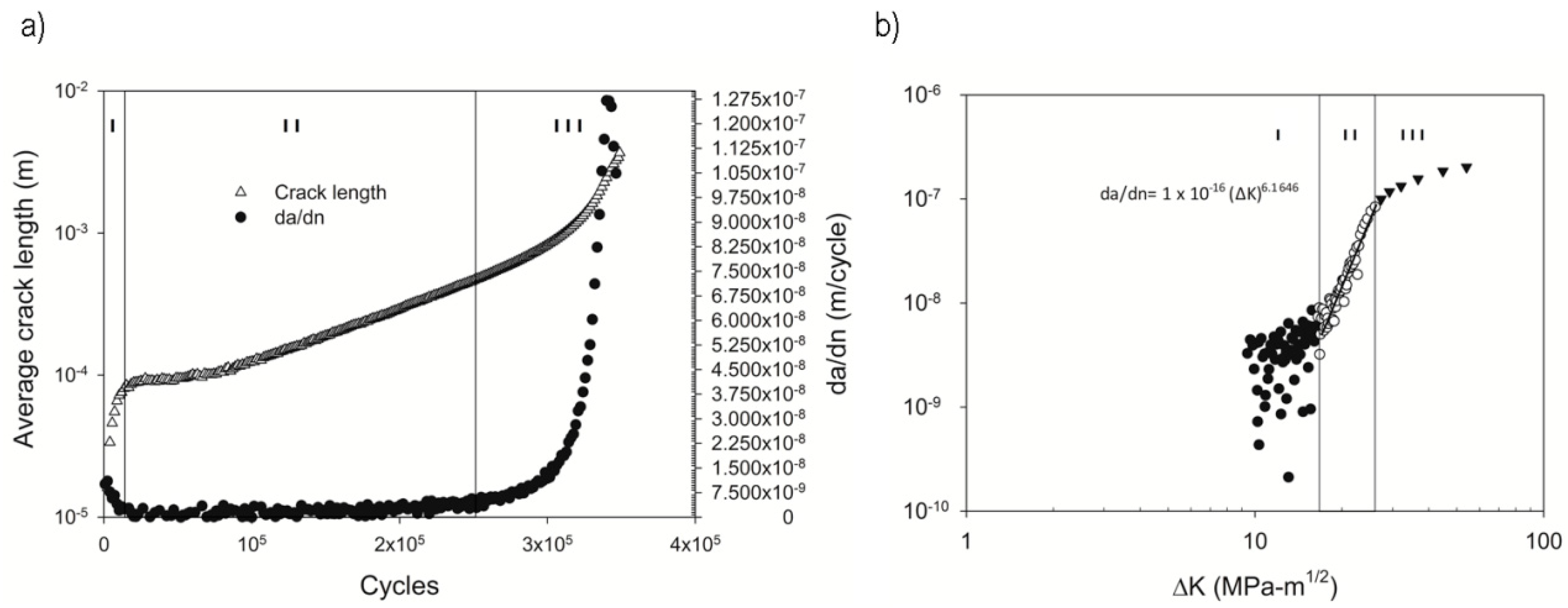
| Element | wt % |
|---|---|
| C | 0.580 |
| Si | 0.260 |
| Mn | 0.885 |
| P | 0.017 |
| S | 0.016 |
| Cr | 0.780 |
| Ni | 0.010 |
| Sr | 0.013 |
| Ti | 0.003 |
| Fe | Balance |
| Stress Amplitude (MPa) | Load (N) | Deflection (mm) | Cycles to Failure at Different Tempering Temperatures | |||
|---|---|---|---|---|---|---|
| 250 °C | 350 °C | 450 °C | 550 °C | |||
| 900 | 205 | 1.862 | 3.04 × 104 | 2.21 × 104 | 3.10 × 104 | 2.75 × 104 |
| 750 | 171 | 1.546 | - | - | - | 1.30 × 105 |
| 600 | 141 | 1.278 | 1.12 × 105 | 2.16 × 105 | 2.41 × 105 | 4.19 × 105 |
| 580 | 133 | 1.202 | - | - | - | runout |
| 500 | 116 | 1.057 | - | 5.13 × 105 | 1.16 × 106 | - |
| 490 | 112 | 1.012 | - | - | runout | - |
| 475 | 109 | 0.985 | - | runout | - | - |
| 400 | 92 | 0.838 | 4.69 × 105 | runout | - | - |
| 325 | 75 | 0.678 | 8.75 × 105 | - | - | - |
| 290 | 67 | 0.606 | runout | - | - | - |
© 2019 by the authors. Licensee MDPI, Basel, Switzerland. This article is an open access article distributed under the terms and conditions of the Creative Commons Attribution (CC BY) license (http://creativecommons.org/licenses/by/4.0/).
Share and Cite
Martinez-Cazares, G.; Mercado-Solis, R.; Bedolla-Gil, Y.; Lozano, D. Continuous Estimation of the Crack Growth Rate during Rotating‒Bending Fatigue Testing. Metals 2019, 9, 275. https://doi.org/10.3390/met9030275
Martinez-Cazares G, Mercado-Solis R, Bedolla-Gil Y, Lozano D. Continuous Estimation of the Crack Growth Rate during Rotating‒Bending Fatigue Testing. Metals. 2019; 9(3):275. https://doi.org/10.3390/met9030275
Chicago/Turabian StyleMartinez-Cazares, Gabriela, Rafael Mercado-Solis, Yaneth Bedolla-Gil, and Diego Lozano. 2019. "Continuous Estimation of the Crack Growth Rate during Rotating‒Bending Fatigue Testing" Metals 9, no. 3: 275. https://doi.org/10.3390/met9030275
APA StyleMartinez-Cazares, G., Mercado-Solis, R., Bedolla-Gil, Y., & Lozano, D. (2019). Continuous Estimation of the Crack Growth Rate during Rotating‒Bending Fatigue Testing. Metals, 9(3), 275. https://doi.org/10.3390/met9030275





